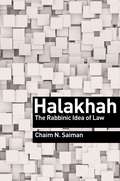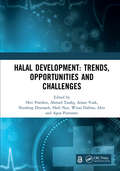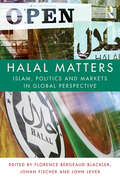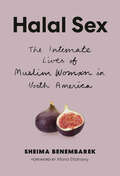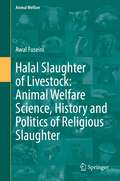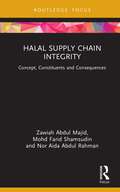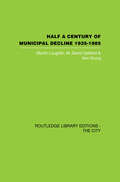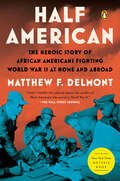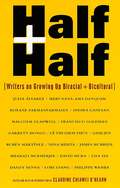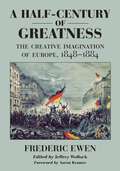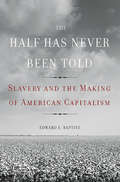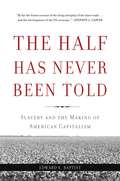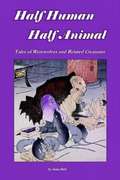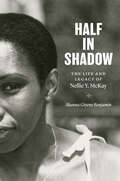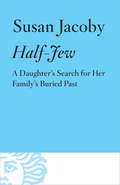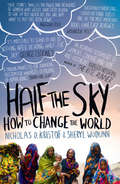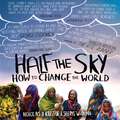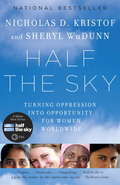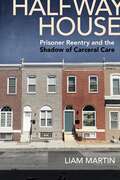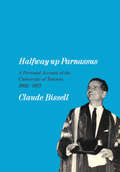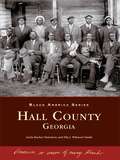- Table View
- List View
The Hakkas of Sarawak
by Kee Howe YongThis book tells the story of the Hakka Chinese in Sarawak, Malaysia, who were targeted as communists or communist sympathizers because of their Chinese ethnicity the 1960s and 1970s. Thousands of these rural Hakkas were relocated into "new villages" surrounded by barbed wire or detained at correction centres, where incarcerated people were understood to be "sacrificial gifts" to the war on communism and to the rule of Malaysia's judicial-administrative regime.The Hakkas of Sarawak looks at how these incarcerated people struggled for survival and dealt with their defeat over the course of a generation. Using methodologies of narrative theory and exchange theory, Kee Howe Yong provides a powerful account of the ongoing legacies of Cold War oppression and its impact on the lives of people who were victimized by these policies.
Halakhah: The Rabbinic Idea of Law (Library of Jewish Ideas #2)
by Chaim N. SaimanHow the rabbis of the Talmud transformed everything into a legal question—and Jewish law into a way of thinking and talking about everythingThough typically translated as “Jewish law,” the term halakhah is not an easy match for what is usually thought of as law. This is because the rabbinic legal system has rarely wielded the political power to enforce its many detailed rules, nor has it ever been the law of any state. Even more idiosyncratically, the talmudic rabbis claim that the study of halakhah is a holy endeavor that brings a person closer to God—a claim no country makes of its law.In this panoramic book, Chaim Saiman traces how generations of rabbis have used concepts forged in talmudic disputation to do the work that other societies assign not only to philosophy, political theory, theology, and ethics but also to art, drama, and literature. In the multifaceted world of halakhah where everything is law, law is also everything, and even laws that serve no practical purpose can, when properly studied, provide surprising insights into timeless questions about the very nature of human existence.What does it mean for legal analysis to connect humans to God? Can spiritual teachings remain meaningful and at the same time rigidly codified? Can a modern state be governed by such law? Guiding readers across two millennia of richly illuminating perspectives, this book shows how halakhah is not just “law” but an entire way of thinking, being, and knowing.
Halal Development: Proceedings of the 1st International Conference on Halal Development (ICHaD 2020), Malang, Indonesia, October 8, 2020
by Heri PratiktoThe increasing demand for halal products, including goods and services, every year, especially for food and beverages, has resulted in a growing need for products with halal guarantees. Along with the increasing trend of the global demand, it has resulted in an increase in producers of halal food and beverages in both Muslim and non-Muslim countries. In addition the demand for halal tourism is also increasing. Indonesia is one of the largest Muslim countries in the world. However, there are still many Muslim consumer actors and Muslim producer actors who do not yet have an awareness of the importance of complying with the provisions of Islamic law in consuming and producing goods and services. There are still many restaurants and hotels that serve food and drinks that are not certified halal. There are still many food, medicinal and cosmetic products that are not halal certified. But now many secular countries such as France, Canada, Australia, the United States, Britain are also halal certified with the aim of meeting the Muslim demand for halal products for food and beverage, including for halal tourism. Starting from the development of the halal industry both in the fields of food, beverages and services, an International Seminar was held, which provides a more complete understanding of halal products, current halal developments and can serve as motivation to produce halal products, providing research results from the topic of halal development. The international seminar, entitled International Conference on Halal Development, listed speakers from several countries able to provide an overview of the halal development of several countries. This book contains a selection of papers from the conference.
Halal Matters: Islam, Politics and Markets in Global Perspective
by Florence Bergeaud-Blackler, Johan Fischer and John LeverIn today’s globalized world, halal (meaning ‘permissible’ or ‘lawful’) is about more than food. Politics, power and ethics all play a role in the halal industry in setting new standards for production, trade, consumption and regulation. The question of how modern halal markets are constituted is increasingly important and complex. Written from a unique interdisciplinary global perspective, this book demonstrates that as the market for halal products and services is expanding and standardizing, it is also fraught with political, social and economic contestation and difference. The discussion is illustrated by rich ethnographic case studies from a range of contexts, and consideration is given to both Muslim majority and minority societies. Halal Matters will be of interest to students and scholars working across the humanities and social sciences, including anthropology, sociology and religious studies.
Halal Sex: The Intimate Lives of Muslim Women in North America
by Sheima BenembarekAn unprecedented glimpse into the sex lives of female and gender-expansive Muslims living across Canada and the United States.In the Muslim world, sex is permissible (or halal) only within the confines of marriage. Outside of wedlock, the act is considered haram, a sin of the faith. Girls are taught to protect their virginity; their mothers, if not forgoing &“the talk&” altogether, obscure the facts with elliptical language and metaphors.So, what happens when immigrants and the children of immigrants set about pursuing an open and active sex life on a more sexually liberated continent, amid western peers and attitudes? The six deeply personal stories in Halal Sex attempt to answer this question, bringing a hushed conversation out into the open.Within these pages you&’ll meet Azar, a non-binary trans Sufi; Bunmi, a Nigerian navigating shame and Tinder; Eman, a lesbian stand-up comic in an interfaith marriage; Taslim, a virgin in her forties struggling to erect healthy boundaries; and Khadijah, an exotic dancer and sex worker.With great empathy, Sheima Benembarek makes space for the honesty and vulnerability of each participant and handles their stories with gentleness and care. What emerges is a tapestry of a diverse Islam—encompassing a wide variety of cultural and religious and socioeconomic backgrounds—and a frank, feminist contribution to the advancement of Muslim sexual education and pleasure.
Halal Slaughter of Livestock: Animal Welfare Science, History and Politics of Religious Slaughter (Animal Welfare #22)
by Awal FuseiniThis unique volume gives insight into the science of slaughter with in-depth discussion of neural communication and the welfare aspects of pre-slaughter handling and slaughter of livestock. The concepts of conscious perception, unconsciousness, stunning, slaughter and death are discussed to provide readers with an understanding of the different events that lead to the conversion of animals into carcasses and subsequently into meat. This accessible work is an excellent resource for learning about welfare issues of different techniques, as it includes historical aspects of religious and conventional slaughter with a focus on the developments around technologies. It comprises the advent of mechanical slaughter in the form of poleaxes to present day use of sophisticated stunning equipment.Moreover, the author covers key aspects of halal meat production and discusses the politics of religious slaughter with an emphasis on the increasing number of anti-halal movements across Europe, America and others. The slaughter of animals for consumption by people of faith is economically significant and has led to a race for market share by multinational retail enterprises. However, there are also ethical and political aspects of religious slaughter which have always divided opinion.The topic of this book provides an important link to the disciplines of animal welfare research, the meat industry and the food business. Scientists, students, as well as government agencies, veterinarians and professionals in food processing and slaughter technology manufacturing will find this an important account. Simplified summaries and practical notes make this reference highly readable.
Halal Supply Chain Integrity: Concept, Constituents and Consequences
by Zawiah Abdul Majid Mohd Farid Shamsudin Nor Aida Abdul RahmanThe market and demand for halal goods and services is ever increasing, and, with it, the importance of supply chain integrity also increases. Integrity, from the perspective of halal logistics service providers, is a prerequisite of halal compliance. This book provides a unique overview of halal supply chain integrity (HSCI) using examples from Malaysia country as a case. The book carefully addresses and simplifies the issues of integrity in halal logistics and supply chain. It gathers findings from studies on halal supply chain integrity conducted in Malaysia, a leading country in halal production, to shed light on current issues, developments and future trends on the theory and practice of halal in the logistics sector. The book discusses factors such as halal quality assurance, trust and commitment and halal assets specificity, in particular. This book will be a useful reference to research scholars and professionals who wish to understand halal logistics and supply chain management and also the importance of protecting integrity of halal services and products.
Half a Century of Municipal Decline: 1935-1985
by Ken Young Martin Loughlin M. David GelfandLocal government passed unscathed through the political and economic upheavals which followed the Great Depression. Contemporary commentators had every reason to look forward to continued growth and expansion in the role of local government, which was seen as the main vehicle for the social programmes of the comeing Welfare State. That optimism was misplaced. Many of the trends of the early twentieth century have been reveresed. From the vantage point of 1985, local government was in crisis so severe that its continued existence was called into question. In this unique book eleven authors explain what happened and how the local government system weakened. Political, financial, economic and legal issues are explored, as are factors such as housing, planning, and social welfare. This book was first published in 1985.
Half American: The Epic Story of African Americans Fighting World War II at Home and Abroad
by Matthew F. Delmont• Winner of the 2023 Anisfield-Wolf Book Award in Nonfiction • A New York Times Notable Book• A Best Book of the Year from TIME, Publishers Weekly, Booklist, Washington Independent Review of Books, and more!The definitive history of World War II from the African American perspective, written by civil rights expert and Dartmouth history professor Matthew Delmont&“Matthew F. Delmont&’s book is filled with compelling narratives that outline with nuance, rigor, and complexity how Black Americans fought for this country abroad while simultaneously fighting for their rights here in the United States. Half American belongs firmly within the canon of indispensable World War II books.&” —Clint Smith, #1 New York Times bestselling author of How the Word Is Passed: A Reckoning with the History of Slavery Across AmericaOver one million Black men and women served in World War II. Black troops were at Normandy, Iwo Jima, and the Battle of the Bulge, serving in segregated units and performing unheralded but vital support jobs, only to be denied housing and educational opportunities on their return home. Without their crucial contributions to the war effort, the United States could not have won the war. And yet the stories of these Black veterans have long been ignored, cast aside in favor of the myth of the &“Good War&” fought by the &“Greatest Generation.&”Half American is American history as you&’ve likely never read it before. In these pages are stories of Black heroes such as Thurgood Marshall, the chief lawyer for the NAACP, who investigated and publicized violence against Black troops and veterans; Benjamin O. Davis, Jr., leader of the Tuskegee Airmen, who was at the forefront of the years-long fight to open the Air Force to Black pilots; Ella Baker, the civil rights leader who advocated on the home front for Black soldiers, veterans, and their families; James Thompson, the 26-year-old whose letter to a newspaper laying bare the hypocrisy of fighting against fascism abroad when racism still reigned at home set in motion the Double Victory campaign; and poet Langston Hughes, who worked as a war correspondent for the Black press. Their bravery and patriotism in the face of unfathomable racism is both inspiring and galvanizing. In a time when the questions World War II raised regarding race and democracy in America remain troublingly relevant and still unanswered, this meticulously researched retelling makes for urgently necessary reading.
Half and Half
by Claudine C. O'HearnAs we approach the twenty-first century, biracialism and biculturalism are becoming increasingly common. Skin color and place of birth are no longer reliable signifiers of one's identity or origin. Simple questions like What are you? and Where are you from? aren't answered--they are discussed.How do you measure someone's race or culture? Half this, quarter that, born here, raised there. What name do you give that? These eighteen essays, joined by a shared sense of duality, address both the difficulties of not fitting into and the benefits of being part of two worlds. Danzy Senna parodies the media's fascination with biracials in a futuristic piece about the mulatto millennium. Garrett Hongo writes about watching his mixed-race children play in a sea of blond hair and white faces, realizing that suburban Oregon might swallow up their unique racial identity. Francisco Goldman shares his frustration with having constantly to explain himself in terms of his Latino and Jewish roots. Malcolm Gladwell understands that being biracial frees him from racial discrimination but also holds him hostage to questions of racial difference. For Indira Ganesan, India and its memory are evoked by the aromas of foods.Through the lens of personal experience, these essays offer a broader spectrum of meaning for race and culture. And in the process, they map a new ethnic terrain that transcends racial and cultural division.From the Hardcover edition.
A Half-Century of Greatness: The Creative Imagination of Europe, 1848-1884
by Frederic EwenChoice Outstanding Academic Title for 2008A Half-Century of Greatness paints a vivid and dramatic picture of the creative thought of mid- to late nineteenth century Europe and the influence of the unsuccessful revolutions of 1848. It reveals often unexpected links between novelists, poets, and philosophers from England, Germany, Austria, Hungary, Russia, and Ukraine—especially Dickens, Carlyle, Mill, the Brontës, and George Eliot; Hegel, Strauss, Feuerbach, Marx, Engels, Wagner, and several German poets; the Hungarian poet Sándor Petöfi; Gogol, Dostoevsky, Bakunin, and Herzen in Russia, and the great Ukrainian poet Shevchenko. Ewen goes on to trace the transition from Romanticism to Victorianism, or what he calls “the Victorian compromise”—the ascendancy of the middle class.The book was reconstructed and edited by Dr. Jeffrey Wollock from Ewen’s final manuscript. It includes the author's own reference citations throughout, a reconstructed bibliography, and an updated “further reading” list.This is Ewen’s last work, the long-lost companion to his Heroic Imagination. Together, these books present a panorama of the social, political, and artistic aspects of European Romanticism, especially foreshadowing and complementing recent work on the relation of Marxism to romanticism. Anyone interested in what Lukacs called “Romantic anticapitalism,”; who appreciates such books as Marshall Berman's Adventures in Marxism or E.P. Thompson's The Romantics (1997), will find Ewen’s work a welcome addition.
The Half Has Never Been Told
by Edward E. BaptistAmericans tend to assume that modern historiography has produced a full and complete understanding of slavery in the United States, as a shameful pre-modern institution, existing in isolation from America’s later success. But while we have long since rejected the idealistic depiction of happy slaves and paternalistic masters, we have not yet begun to grapple with the full extent of slavery’s horrors#151;or its link to the expansion of the country, the political battles that caused the Civil War, or the growth of our modern capitalist economy. . As historian Edward Baptist reveals in The Half Has Never Been Told, slavery and its expansion were central to the evolution and modernization of our nation in the 18th and 19th centuries, catapulting the US into a modern, industrial and capitalist economy. In the span of a single lifetime, the South grew from a narrow coastal strip of worn-out tobacco plantations to a sub-continental cotton empire. By 1861 it had five times as many slaves as it had during the Revolution, and was producing two billion pounds of cotton a year. It was through slavery and slavery alone that the United States achieved a virtual monopoly on the production of cotton, the key raw material of the Industrial Revolution, and was transformed into a global power rivaled only by England. The Half Has Never Been Told begins in 1787, when Northern emancipation and falling profits from Southern tobacco threatened the future of American slavery. Seeking desperately to prevent this collapse, innovative Southern enslavers brought slavery out of the Southeast’s decaying coastal plantation belts, leading trains of men, women, and children to the frontier states where the labor-intensive cotton crop beckoned. By 1860, their empire of cotton and labor camps stretched all the way to Texas. During America’s formative years, Baptist explains, our chief form of innovation was slavery, and ways to make slavery increasingly profitable. Through forced migration, quotas, and torture, slave owners extracted continual increases in efficiency from their slaves making competition with American cotton fields near impossible. Financial innovations and banks, meanwhile, helped feed credit to the cotton plantations, spurring on economic expansion and confirming for enslavers and their political leaders that their livelihood, and the American economy, depended on cotton. Despite the mayhem wreaked upon them, enslaved African-Americans survived, clinging desperately to the ability to name the evil they confronted. By the time of Abraham Lincoln’s election, the stories they smuggled out of the whipping-machine had helped to put the North and South on the collision course that led to the Civil War, national emancipation, and the collapse of the Southern slave industry#151;a system that, Baptist suggests, might otherwise have gone on indefinitely. Using thousands of interviews with former slaves, hundreds of plantation records, newspapers, and the personal papers of dozens of politicians, entrepreneurs, and escaped slaves, The Half Has Never Been Told unveils, at last, the most savage secrets at the heart of American history. These intimate stories of survival and tragedy transform our understanding of the rise of the American nation, the outbreak of the Civil War, and the birth of entrepreneurial capitalism. A much-needed challenge to the reigning narratives of slavery, The Half Has Never Been Told reveals the alarming extent to which our country’s success was irrevocably tied to the institution of slavery.
The Half Has Never Been Told
by Edward E. BaptistAmericans tend to assume that modern historiography has produced a full and complete understanding of slavery in the United States, as a shameful pre-modern institution, existing in isolation from America’s later success. But while we have long since rejected the idealistic depiction of happy slaves and paternalistic masters, we have not yet begun to grapple with the full extent of slavery’s horrors--or its link to the expansion of the country, the political battles that caused the Civil War, or the growth of our modern capitalist economy. . As historian Edward Baptist reveals in The Half Has Never Been Told, slavery and its expansion were central to the evolution and modernization of our nation in the 18th and 19th centuries, catapulting the US into a modern, industrial and capitalist economy. In the span of a single lifetime, the South grew from a narrow coastal strip of worn-out tobacco plantations to a sub-continental cotton empire. By 1861 it had five times as many slaves as it had during the Revolution, and was producing two billion pounds of cotton a year. It was through slavery and slavery alone that the United States achieved a virtual monopoly on the production of cotton, the key raw material of the Industrial Revolution, and was transformed into a global power rivaled only by England. The Half Has Never Been Told begins in 1787, when Northern emancipation and falling profits from Southern tobacco threatened the future of American slavery. Seeking desperately to prevent this collapse, innovative Southern enslavers brought slavery out of the Southeast’s decaying coastal plantation belts, leading trains of men, women, and children to the frontier states where the labor-intensive cotton crop beckoned. By 1860, their empire of cotton and labor camps stretched all the way to Texas. During America’s formative years, Baptist explains, our chief form of innovation was slavery, and ways to make slavery increasingly profitable. Through forced migration, quotas, and torture, slave owners extracted continual increases in efficiency from their slaves making competition with American cotton fields near impossible. Financial innovations and banks, meanwhile, helped feed credit to the cotton plantations, spurring on economic expansion and confirming for enslavers and their political leaders that their livelihood, and the American economy, depended on cotton. Despite the mayhem wreaked upon them, enslaved African-Americans survived, clinging desperately to the ability to name the evil they confronted. By the time of Abraham Lincoln’s election, the stories they smuggled out of the whipping-machine had helped to put the North and South on the collision course that led to the Civil War, national emancipation, and the collapse of the Southern slave industry--a system that, Baptist suggests, might otherwise have gone on indefinitely. Using thousands of interviews with former slaves, hundreds of plantation records, newspapers, and the personal papers of dozens of politicians, entrepreneurs, and escaped slaves, The Half Has Never Been Told unveils, at last, the most savage secrets at the heart of American history. These intimate stories of survival and tragedy transform our understanding of the rise of the American nation, the outbreak of the Civil War, and the birth of entrepreneurial capitalism. A much-needed challenge to the reigning narratives of slavery, The Half Has Never Been Told reveals the alarming extent to which our country’s success was irrevocably tied to the institution of slavery.
The Half Has Never Been Told: Slavery and the Making of American Capitalism
by Edward E. BaptistAmericans tend to cast slavery as a pre-modern institution-the nation's original sin, perhaps, but isolated in time and divorced from America's later success. But to do so robs the millions who suffered in bondage of their full legacy.As historian Edward Baptist reveals in The Half Has Never Been Told, the expansion of slavery in the first eight decades after American independence drove the evolution and modernization of the United States. In the span of a single lifetime, the South grew from a narrow coastal strip of worn-out tobacco plantations to a continental cotton empire, and the United States grew into a modern, industrial, and capitalist economy. Until the Civil War, Baptist explains, the most important American economic innovations were ways to make slavery ever more profitable. Through forced migration and torture, slave owners extracted continual increases in efficiency from enslaved African Americans. Thus the United States seized control of the world market for cotton, the key raw material of the Industrial Revolution, and became a wealthy nation with global influence.Told through intimate slave narratives, plantation records, newspapers, and the words of politicians, entrepreneurs, and escaped slaves, The Half Has Never Been Told offers a radical new interpretation of American history. It forces readers to reckon with the violence at the root of American supremacy, but also with the survival and resistance that brought about slavery's end-and created a culture that sustains America's deepest dreams of freedom.
Half Human, Half Animal: Tales Of Werewolves And Related Creatures
by Jamie HallIn the pages you are about to read, you will meet many legendary creatures. All of them have one thing in common: they transform. Everyone knows what a werewolf is, and most people have seen at least a couple of werewolf movies. Others will be less familiar to you, such as the feline cousins of werewolves, the werecats. I doubt that the word "werecat" is part of your vocabulary, yet the concept of a person who can transform into a cat is a fairly common idea.
Half in Shadow: The Life and Legacy of Nellie Y. McKay
by Shanna Greene BenjaminNellie Y. McKay (1930–2006) was a pivotal figure in contemporary American letters. The author of several books, McKay is best known for coediting the canon-making Norton Anthology of African American Literature with Henry Louis Gates Jr., which helped secure a place for the scholarly study of Black writing that had been ignored by white academia. However, there is more to McKay's life and legacy than her literary scholarship. After her passing, new details about McKay's life emerged, surprising everyone who knew her. Why did McKay choose to hide so many details of her past? Shanna Greene Benjamin examines McKay's path through the professoriate to learn about the strategies, sacrifices, and successes of contemporary Black women in the American academy. Benjamin shows that McKay's secrecy was a necessary tactic that a Black, working-class woman had to employ to succeed in the white-dominated space of the American English department. Using extensive archives and personal correspondence, Benjamin brings together McKay's private life and public work to expand how we think about Black literary history and the place of Black women in American culture.
Half in Shadow: The Life and Legacy of Nellie Y. McKay
by Shanna Greene BenjaminNellie Y. McKay (1930–2006) was a pivotal figure in contemporary American letters. The author of several books, McKay is best known for coediting the canon-making with Henry Louis Gates Jr., which helped secure a place for the scholarly study of Black writing that had been ignored by white academia. However, there is more to McKay's life and legacy than her literary scholarship. After her passing, new details about McKay's life emerged, surprising everyone who knew her. Why did McKay choose to hide so many details of her past? Shanna Greene Benjamin examines McKay's path through the professoriate to learn about the strategies, sacrifices, and successes of contemporary Black women in the American academy. Benjamin shows that McKay's secrecy was a necessary tactic that a Black, working-class woman had to employ to succeed in the white-dominated space of the American English department. Using extensive archives and personal correspondence, Benjamin brings together McKay’s private life and public work to expand how we think about Black literary history and the place of Black women in American culture.
Half-Jew
by Susan JacobySince childhood, Susan Jacoby, the New York Times bestselling author of The Age of American Unreason, was sure that her father was keeping a secret. At age twenty, just before beginning her writing career as a reporter for the Washington Post, she learned the truth: Robert Jacoby, a Catholic convert with a Catholic wife, was also a Jew. In Half-Jew, Jacoby grapples with the hidden identity cloaked by the persona of a successful accountant and member of St. Thomas Aquinas Church in East Lansing, Michigan--and with the secrets and lies that had marked her family's history for three generations on two continents. Beginning in 1849 when her great-grandfather arrived in America as a political refugee, Jacoby traces her lineage through the lives of her great-uncle Harold, the distinguished astronomer whose map of the constellations is etched on the ceiling of Grand Central Terminal; her uncle, the bridge champion Oswald Jacoby, her aunt Edith, also a Catholic convert and eventually a reformer within the church; and, of course her father himself. At the core of story is the psychic damage that accrues across generations when people conceal their true ethnic and religious origins. Featuring a new afterword, Half-Jew is a meticulously researched, emotionally poignant examination of the dark legacy of European and American anti-Semitism as well as a tender-hearted account of a daughter coming to understand her father, herself, and her family's true legacy.
Half The Sky: How to Change the World
by Nicholas D. Kristof Sheryl WuDunnPulitzer Prize-winning reporting team, husband and wife Nicholas D. Kristof and Sheryl WuDunn, take us on a journey through Africa and Asia to meet an extraordinary array of exceptional women struggling against terrible circumstances. More girls have been killed in the last fifty years, precisely because they are girls, than men were killed in all the wars of the twentieth century combined. More girls are killed in this routine 'gendercide' in any one decade than people were slaughtered in all the genocides of the twentieth century. In the nineteenth century, the central moral challenge was slavery. In the twentieth, it was totalitarianism. In the twenty-first, Kristof and WuDunn demonstrate, it will be the struggle for gender equality in the developing world. Fierce, moral, pragmatic, full of amazing stories of courage and inspiration, HALF THE SKY is essential reading for every global citizen.
Half The Sky: How to Change the World
by Nicholas D. Kristof Sheryl WuDunnPulitzer Prize-winning reporting team, husband and wife Nicholas D. Kristof and Sheryl WuDunn, take us on a journey through Africa and Asia to meet an extraordinary array of exceptional women struggling against terrible circumstances. More girls have been killed in the last fifty years, precisely because they are girls, than men were killed in all the wars of the twentieth century combined. More girls are killed in this routine 'gendercide' in any one decade than people were slaughtered in all the genocides of the twentieth century. In the nineteenth century, the central moral challenge was slavery. In the twentieth, it was totalitarianism. In the twenty-first, Kristof and WuDunn demonstrate, it will be the struggle for gender equality in the developing world. Fierce, moral, pragmatic, full of amazing stories of courage and inspiration, HALF THE SKY is essential reading for every global citizen.
Half the Sky: Turning Oppression into Opportunity for Women Worldwide
by Nicholas D. Kristof Sheryl WuDunn#1 NATIONAL BESTSELLER • A passionate call to arms against our era&’s most pervasive human rights violation—the oppression of women and girls in the developing world. From the bestselling authors of Tightrope, two of our most fiercely moral voicesWith Pulitzer Prize winners Nicholas D. Kristof and Sheryl WuDunn as our guides, we undertake an odyssey through Africa and Asia to meet the extraordinary women struggling there, among them a Cambodian teenager sold into sex slavery and an Ethiopian woman who suffered devastating injuries in childbirth. Drawing on the breadth of their combined reporting experience, Kristof and WuDunn depict our world with anger, sadness, clarity, and, ultimately, hope.They show how a little help can transform the lives of women and girls abroad. That Cambodian girl eventually escaped from her brothel and, with assistance from an aid group, built a thriving retail business that supports her family. The Ethiopian woman had her injuries repaired and in time became a surgeon. A Zimbabwean mother of five, counseled to return to school, earned her doctorate and became an expert on AIDS.Through these stories, Kristof and WuDunn help us see that the key to economic progress lies in unleashing women&’s potential. They make clear how so many people have helped to do just that, and how we can each do our part. Throughout much of the world, the greatest unexploited economic resource is the female half of the population. Countries such as China have prospered precisely because they emancipated women and brought them into the formal economy. Unleashing that process globally is not only the right thing to do; it&’s also the best strategy for fighting poverty.Deeply felt, pragmatic, and inspirational, Half the Sky is essential reading for every global citizen.
Halfway Home: Race, Punishment, and the Afterlife of Mass Incarceration
by Reuben Jonathan MillerA &“persuasive and essential&” (Matthew Desmond) work that will forever change how we look at life after prison in America through Miller&’s &“stunning, and deeply painful reckoning with our nation&’s carceral system&” (Heather Ann Thompson) Each year, more than half a million Americans are released from prison and join a population of twenty million people who live with a felony record. Reuben Miller, a chaplain at the Cook County Jail in Chicago and now a sociologist studying mass incarceration, spent years alongside prisoners, ex-prisoners, their friends, and their families to understand the lifelong burden that even a single arrest can entail. What his work revealed is a simple, if overlooked truth: life after incarceration is its own form of prison. The idea that one can serve their debt and return to life as a full-fledge member of society is one of America&’s most nefarious myths. Recently released individuals are faced with jobs that are off-limits, apartments that cannot be occupied and votes that cannot be cast. As The Color of Law exposed about our understanding of housing segregation, Halfway Home shows that the American justice system was not created to rehabilitate. Parole is structured to keep classes of Americans impoverished, unstable, and disenfranchised long after they&’ve paid their debt to society. Informed by Miller&’s experience as the son and brother of incarcerated men, captures the stories of the men, women, and communities fighting against a system that is designed for them to fail. It is a poignant and eye-opening call to arms that reveals how laws, rules, and regulations extract a tangible cost not only from those working to rebuild their lives, but also our democracy. As Miller searchingly explores, America must acknowledge and value the lives of its formerly imprisoned citizens.
Halfway House: Prisoner Reentry and the Shadow of Carceral Care (Alternative Criminology #26)
by Liam MartinAn inside look at the struggles former prisoners face in reentering society Every year, roughly 650,000 people prepare to reenter society after being released from state and federal prisons. In Halfway House, Liam Martin shines a light on their difficult journeys, taking us behind the scenes at Bridge House, a residential reentry program near Boston, Massachusetts. Drawing on three years of research, Martin explores the obstacles these former prisoners face in the real world. From drug addiction to poverty, he captures the ups and downs of life after incarceration in vivid, engaging detail. He shows us what, exactly, it is like to live in a halfway house, giving us a rare, up-close view of its role in a dense and often confusing web of organizations governing prisoner reentry. Martin asks us to rethink the possibilities—and pitfalls—of using halfway houses to manage the worst excesses of mass incarceration. A portrait of life in the long shadow of the carceral state, Halfway House lets us see the struggles of reentry through the eyes of former prisoners.
Halfway up Parnassus: A Personal Account of the U of T, 1932-1971
by Claude BissellHalfway up Parnassus is a personal account of the University of Toronto with particular emphasis on the period when Dr. Bissell was its president, from 1958 to 1971. The first half of that period was the flowering of the old, self-confident university, with its established patterns of government, and its untroubled constituents. The second half saw the slow, powerful emergence of a new university, uncertain of itself and its role, seeking to find a form for democratic aspirations--not, however, without some dramatic confrontations with left-wing students. Nowhere in Canada was the process more sharply defined than at the University of Toronto. This book records that process from the point of view of a major participant. It is also intended as a series of portraits of major academic figures and as an intimate recollection of a society that is passing away.It is not a philosophical book about education, but a human document--an attempt to render the tone of academic society, and in this account Dr. Bissell has combined, to great effect, autobiography, descriptive narration, and historical analysis. The book will be of interest to Canadians concerned about our intellectual and cultural life, and to academic societies everywhere.
Hall County, Georgia (Black America Series)
by Linda Rucker Hutchens Ella J. SmithLocated in the foothills of the Blue Ridge Mountains in Northeast Georgia, Hall County and the city of Gainesville have been significantly enriched by the contributions of their African-American residents. Hall County, Georgia is a retrospective photographic album; it is a glimpse of the past, featuring an array of churches, schools, businesses, and outstanding leaders in the African-American community.

